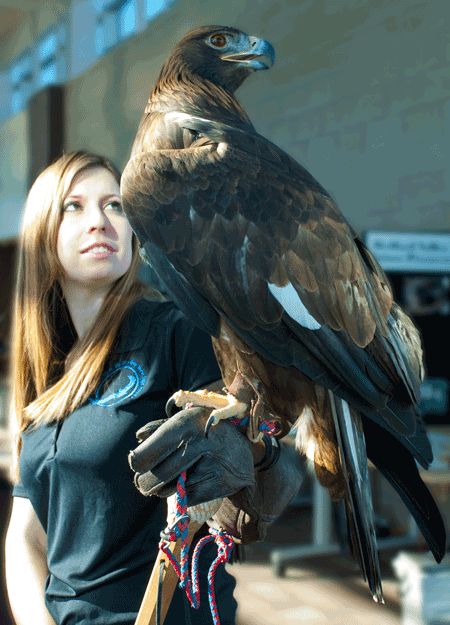Ph.D. candidate uses genetics to aid eagle conservation
Friday, February 19, 2016

Megan Judkins, a Ph.D. candidate at Oklahoma State University, began volunteering at the Iowa Tribe of Oklahoma’s Grey Snow Eagle House near Perkins in 2006, where she is now the assistant manager.
“I’ve wanted to do this ever since I started volunteering there,” Judkins said. “Bringing these birds who are suffering from some sort of injury is rewarding.”
Originally from Lawton, Oklahoma, Judkins received her bachelor of science in natural resource ecology and management from OSU in 2009. In 2012, she earned her MBA online from Marylhurst University in Marylhurst, Oregon. She’s set to complete her doctorate in integrative biology in May 2017.
“We use genetic technology to breakdown the range of each species into DNA zip codes to know where each animal we receive comes from as well as eagles that may have been illegally shot or killed by various industry sectors,” she said. “We’ve analyzed genomes from 200 bald eagles and 36 golden eagles.”
Judkins has been interested in a study sampling eagle’s nests in New Jersey where blood was collected from hatchlings for over 30 years to understand the turnover rates of the birds and how closely related they are when it comes to mating. She plans to incorporate this study into her dissertation, establishing a database of genetic information on eagles.
“Studying helps us learn how these birds function in the wild,” she said. “They almost went extinct from a pesticide that was killing the adults and preventing new hatchings. There were about 100,000 nesting pairs in the U.S., and at one point, it dropped to 487 pairs. Since then, the population has grown to 10,000. Studying these ranges helps to prevent something like this from happening again.”
Located 2 miles south of Perkins, Oklahoma, the Grey Eagle Snow House is celebrating its 10th year. It’s mission is to rehabilitate injured eagles so they can be released back into the wild, provide non-releasable eagles with homes, as well as conduct research and provide education. The Grey Eagle Snow House is also the only facility in the country with permits necessary to complete its mission in eagle rehabilitation and to partner with the university for educational purposes.
“I enjoy being able to teach people and show them these magnificent animals in the hopes that they’ll take that information with them,” she said. “It amazes me how much people don’t know about them. For example, eagles can see eight to 10 times better than us. They also have 7,000 different feathers and have control over each one of them.”
The Grey Eagle Snow House receives more than 12,000 visitors from all over the world. It has successfully released 20 eagles back into the wild, with the latest two being released Jan. 30. For more information on the rehabilitation center, visit eagles.iowanation.org. More info on Judkins’ research can be found at meganjudkins.wix.com/research.
Story by Matt Cohlmia
PHOTOS: https://www.flickr.com/photos/ostatenews/albums/72157664032001086
